The Karen Hill Tribes near Chiang Mai offer a glimpse into the lives of these unique cultures of refugees. But a visit with the “Kayin” may not be all that it appears to be.
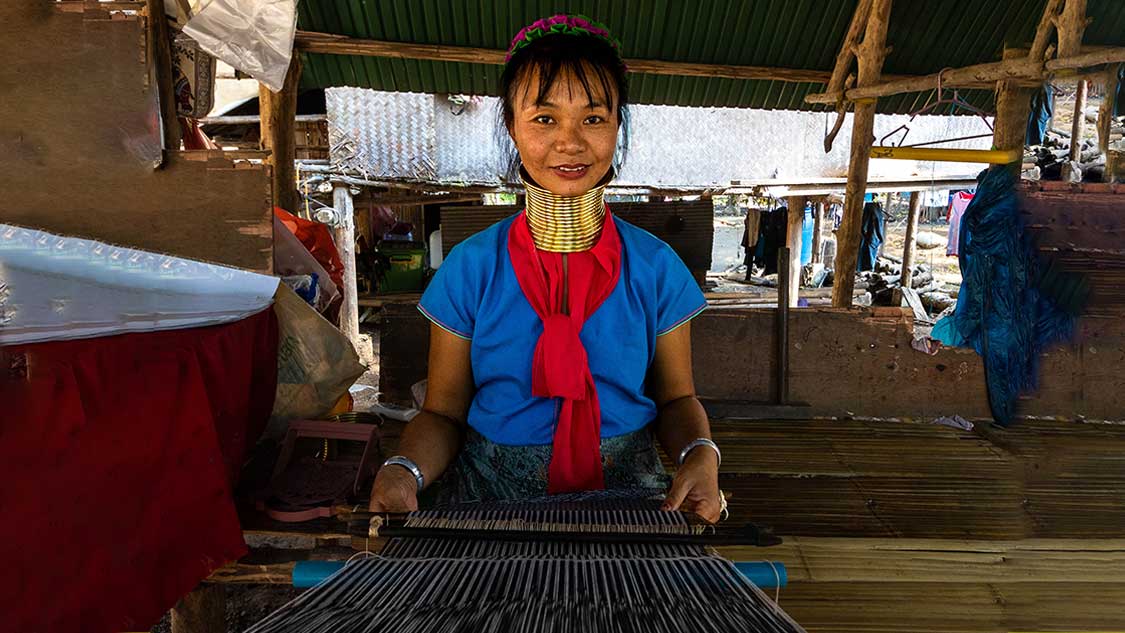
Although my family had seen photos of the hill tribes of Thailand, nothing could really prepare us for the reality of visiting the Karen tribes near the city of Chiang Mai.
Our visit wasn’t the one that we had hoped for. It wasn’t one that “lived up to our expectations.” But visiting the Karen hill tribes near Chiang Mai was something I’ll never forget. And I don’t regret visiting. Because my whole family learned a LOT in a very short amount of time.
Our journey to the hill tribes in Thailand was part of a day trip through the mountains to visit Bua Tong Sticky Waterfall in Lanna National Park. And our visit to the Karen village near Chiang Mai was one that was unceremonious, abrupt, confusing and eye-opening all at once.
Who Are The Karen Hill Tribes in Thailand?
Table of Contents
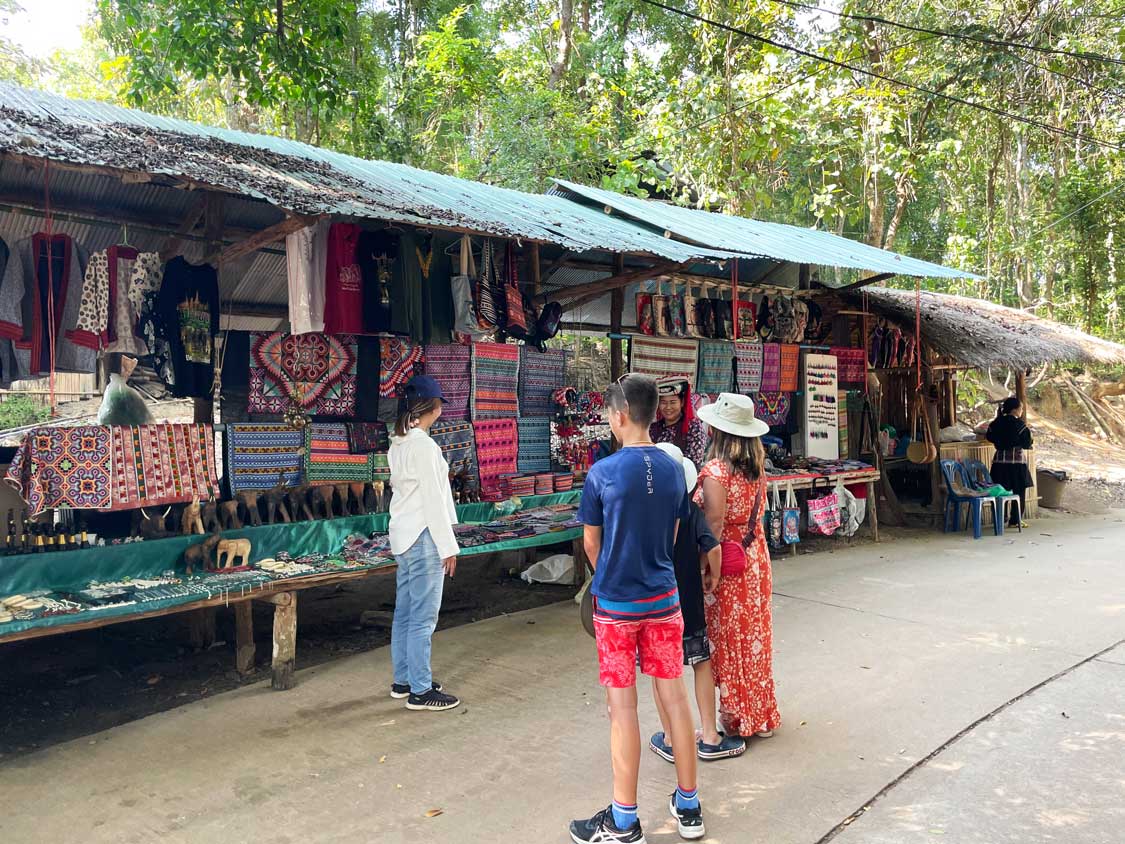
When my family first learned of the Karen people of Thailand, we were presented with the same images that most people link with this community: slender women with rows upon rows of brass rings snaking up their necks. This unique form of decoration earned some of them the moniker the “Long Neck Karen Tribe.”
The Karen Hill Tribe, as most people know them, isn’t one culture at all. In fact, there are four unique Karen nations in communities located in villages throughout Thailand, especially in the north. These are all ethnic communities that predominantly resided in Myanmar(Burma) before being forced out by an authoritarian government during a cultural genocide.
My family had learned a little bit about the plight of these refugees while we stayed in a floating lodge in Sai Yok National Park in Kanchanaburi. The lodge was run by a village of Mon people, themselves former Burmese refugees who sought shelter in Thailand after being forced out of their homes.
During our time on the Kwai River, we met a man who was working to save the Mon language, as many of the refugees had left their home villages in the mountains in search of opportunities in large cities like Phuket, Bangkok, and Chiang Mai.
When he wasn’t working as a guide for the lodge, he was inviting Mon children from throughout the country to his village to learn their historic language and alphabet in his makeshift schoolhouse filled with donated books.
The Mon are just one of the hill communities that now reside in Thailand. These groups, sometimes called “Kariang/Gariang” or “Kayin,” actually refer to themselves as “Pakanyor.” Each of these communities has its own language, customs, and fashion. They also each have their own language.
Some of these communities have set up separate villages, while others band together in communal villages that include members of each of the hill tribes. That is the type of village that my family visited.
Visiting The Karen Tribes Near Chiang Mai
We rolled up to the Baan Tong Luang hill tribe village, about an hour from central Chiang Mai at about ten in the morning. My boys were both still a little sleepy-eyed from our long day of travel from Bangkok the previous day but were excited to see something new.
As we entered the village, alarm bells began to sound in my “sustainable and responsible” travel brain. The village had all of the hallmarks of a makeshift tourist trap. There were narrow lanes dotted by thatch huts and lined, almost exhaustingly, with tables selling the same repeating trinkets one after another.
As we wandered amongst the huts, even my two boys were having a hard time deciphering what was authentic and what was genuine.
Kayin Villages Are Not All That They Appear To Be. And Not All That They Appear Not To Be
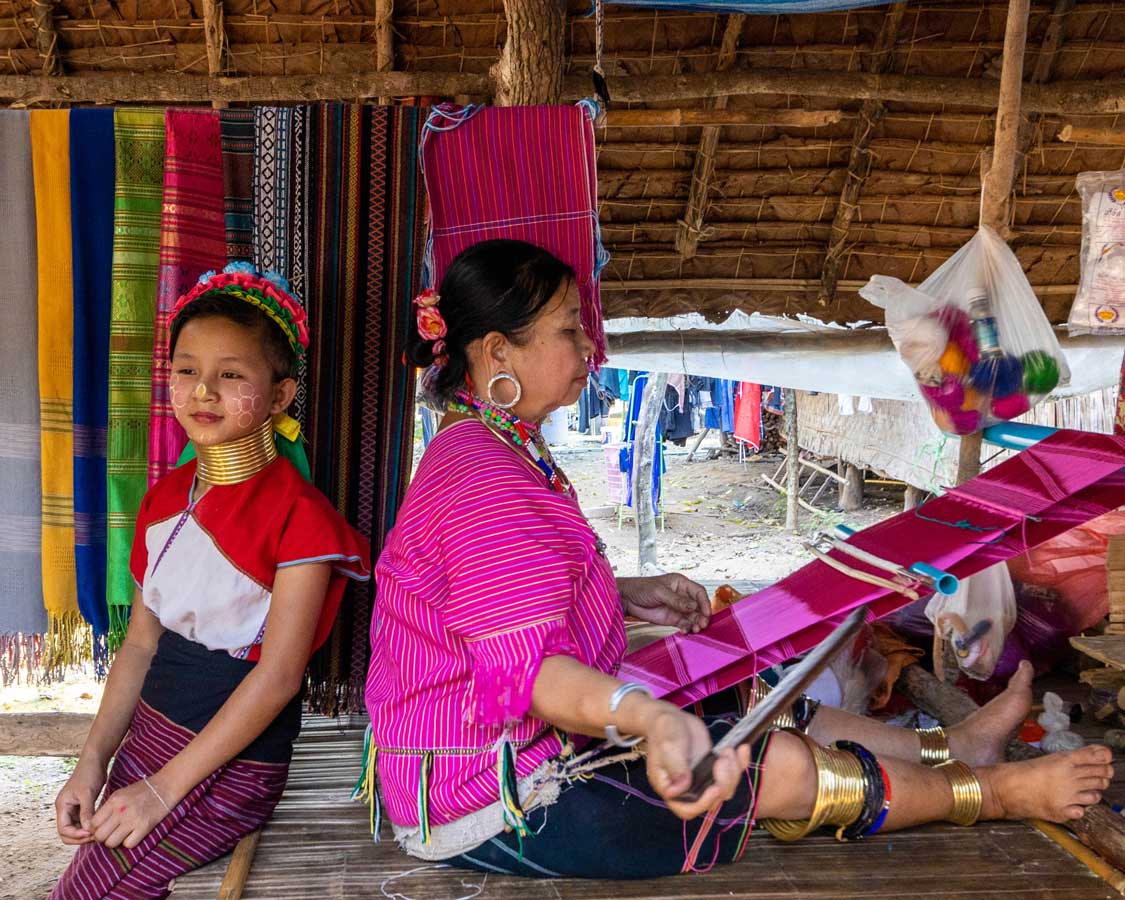
The entire entrance to the Karen village, with its small entrance fee and endless trinket stalls, seemed as far from a “genuine” travel experience as I’d ever encountered. Line upon line of dramatically-dressed “locals,” all with flashing neck jewelry, like right out of a National Geographic story.
The entire experience seemed. As we walked the narrow lanes, my nine-year-old son, D, caught a glimpse of a small child darting between the stilt legs of the huts. There was a flash of a smile between the two, and they were quickly chasing each other in a makeshift game of hide and seek that soon saw other children from the village join in the fun.
As we stopped at one stall, where a woman from the long-neck tribe was weaving blankets, a young girl in brightly colored clothes that D was playing with hopped up beside her. Through our interpreter, I asked the woman weaving whether this was her daughter. She smiled and nodded, a proud look spreading across her face.
She looked at my boys and said, “It’s nice to see children playing together.” We spoke briefly about her weaving, where her designs come from, and how her village came to include all four Karen hill tribes. She told us that she was from the Sgaw, or “White Karen” tribe. Her daughter was dressed as a Long Neck Karen because “it brings in more money.”
A Collaboration For Survival
Baan Tong Luang hill tribe village includes members of all four of the Karen hill tribes near Chiang Mai, the Sgaw (White Karen), Po (Red Karen or long-neck Karen), Pa-O, and the Kayah. The community came together because they knew they would make a great tourist attraction.
The different tribes work together as a community to draw visitors in and pay for infrastructure that helps ensure that visitors keep coming back. They make money from a small entrance fee that visitors pay to access the village and from the sale of trinkets, handicrafts, and products that are made right there in the village.
The money that they make is a pittance when compared to the money that tour guides make bringing foreigners to visit the Karen hill tribes. Very little, if any, of that money ever goes toward the villages that tour companies profit upon.
Many hill tribes, many of whom have members who have never been granted Thai citizenship, use this type of tourism as the only way for them to make money, as they can’t work legally within the country.
Music Brings People Together
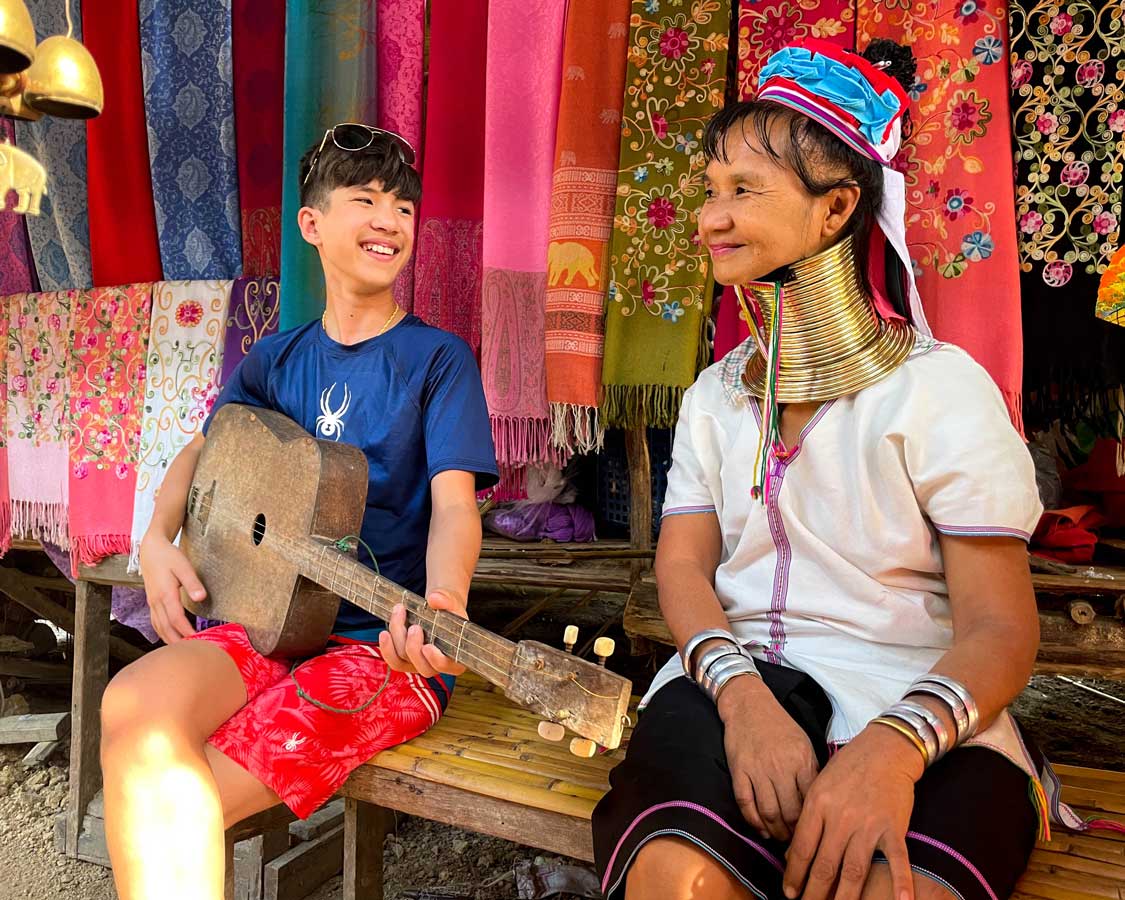
As we continued through the village, C, my eleven-year-old, noticed a woman from the Long Neck Tribe plucking away at a guitar. C plays guitar and was instantly drawn to the woman. We walked over together and asked about her instrument.
Her guitar was hand-made from wood sourced from the forest behind the village. Its unique four-string design was one that she was used to playing, and she played a wonderful song for us. C asked to give the guitar a try, and they worked together through our interpreter on how the notes work on the instrument. Soon they were strumming together and having a wonderful time.
As they played, I noticed that she had some unique trinkets for sale, including a magnet of her and her guitar. She said that the magnet was made in the village. It’s tough to say whether something like that could be made in this simple village, but the connection was there, and it’s now hanging up on my fridge.
Made In House
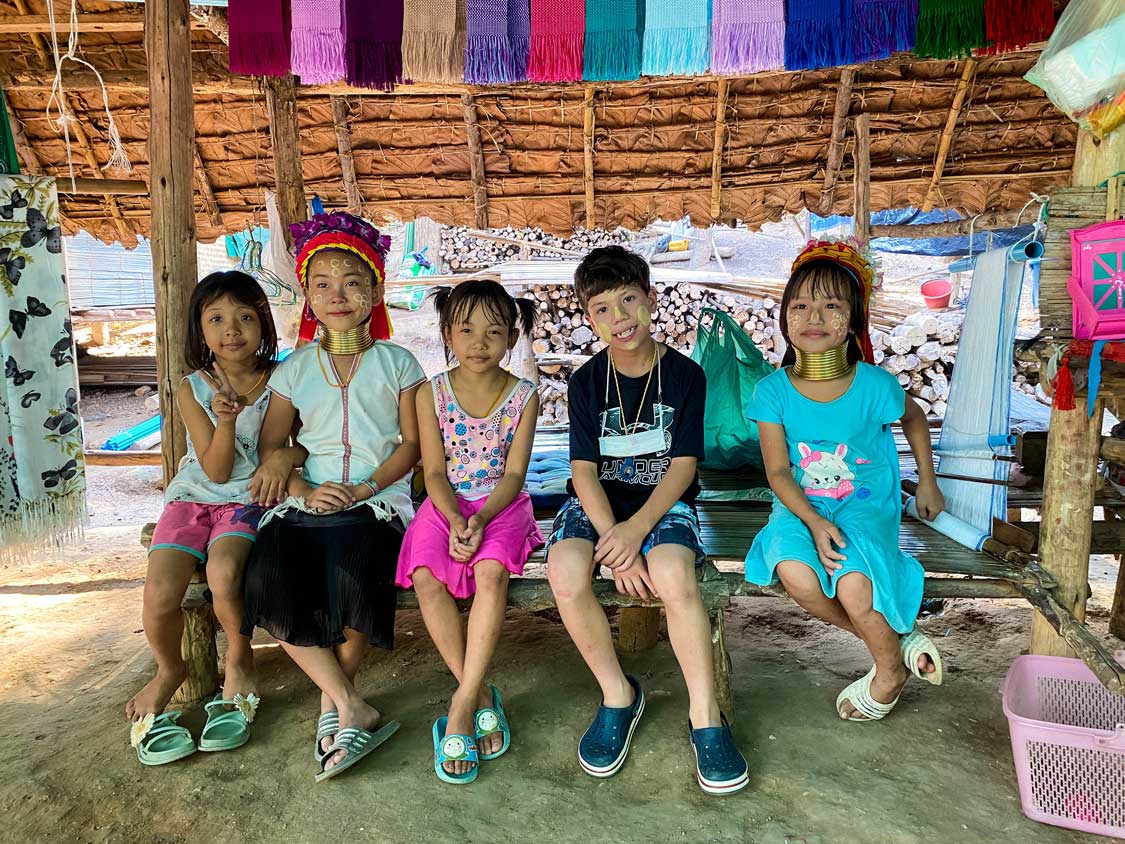
While a lot of the trinkets in the Karen Village near Chiang Mai had a definite “made in China” scent to them, there are a few items that are no doubt authentic. There were women weaving scarves, blankets, and clothes with brightly-colored hues that were almost impossible to ignore.
While we were visiting the Mon village in Kanchanaburi, we loved seeing the intricate use of sunscreen, not only used to protect against the sun’s harsh rays but also as a type of decoration used on faces and arms.
As we reached the end of the village we saw a group of children who had similar designs on their faces. One ran up to D and drew a series of dots and swirls on his face, giggling before running away. My wife asked one of the women near her about the cream. She was told that it was a sunscreen made from local minerals and that it’s always been tradition and fun to use it as a form of self-expression as well.
Pretty soon we were all wearing our own mineral sunscreen in splashes across our faces.
Is Visiting Karen Hill Tribes Ethical?
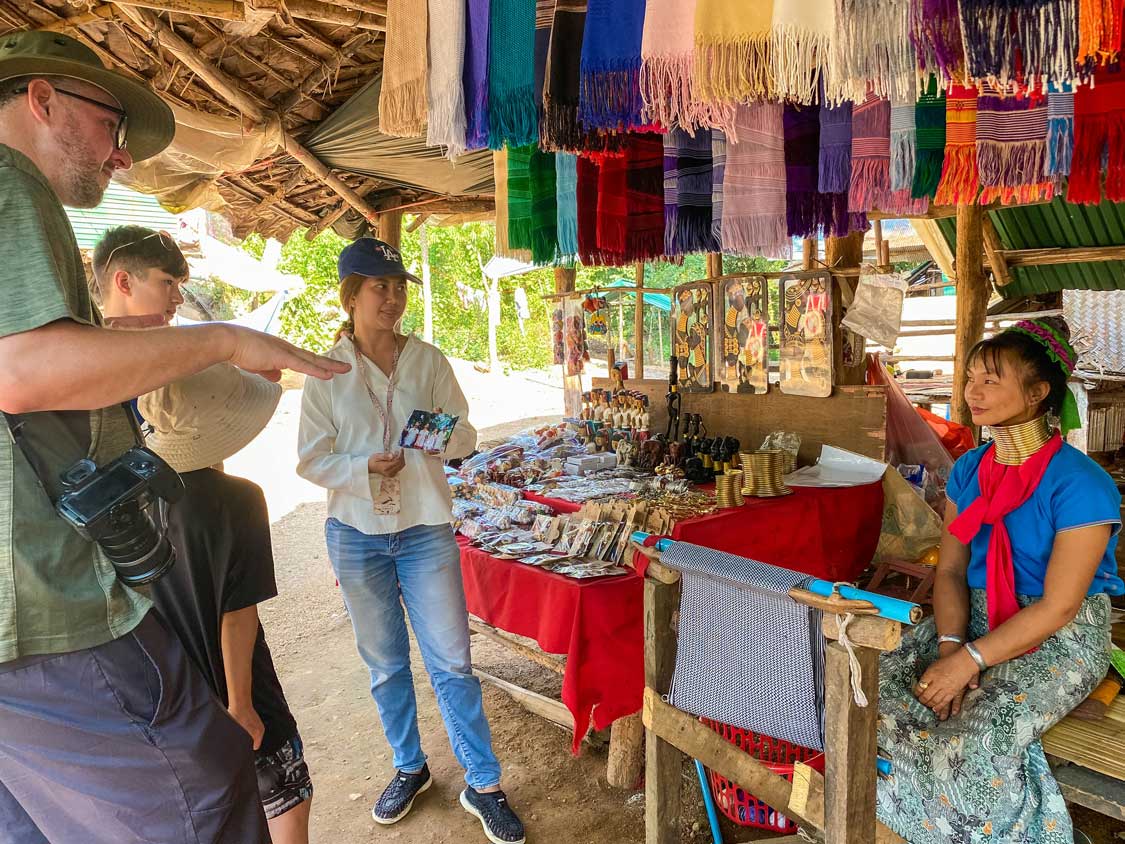
I wanted my first experience with the Karen hill tribes near Chiang Mai to be a magical, authentic experience. I didn’t get what I asked for. However, I learned an important lesson about how tourism impacts local communities, especially those who rely on it to survive.
I also got a wonderful chance to see how children can be the barrier breaker in cultural immersion. If it wasn’t for my son seeing a child and instantly connecting with play, I may have never learned all that I did from this tourist attraction. And I may have come away from it with a completely different perspective, one that may not have been near as positive.
There have been many concerns, especially in recent years, about the ethics of visiting the Karen hill tribes in Thailand. Much of this revolves around their loss of culture and exploitation by tour operators. And it’s very true that some of these wonderful and unique people are being exploited.
I probably wouldn’t bring my family back to this same village, as I don’t believe that it offers the most positive experience for either visitors or the hill tribes themselves. But it is possible to visit these Northern Thailand hill tribe villages ethically.
Look for small group tours that offer village homestays, where visitors spend a few nights living with one of the hill tribe families. Sometimes, this might mean sleeping on a floor or living without “Western” amenities for a couple of days. But you’ll be putting more money back into the local economy and helping out people in a way that buying a two-dollar trinket never could.
Our Family Travel In Chiang Mai Video
Have You Visited The Karen Hill Tribes Near Chiang Mai?
Thailand was a magical destination for family travel. But this country does have some poor track records in ethical tourism. Among those is the continued promotion of elephant rides and the exploitation of some sections of the Thailand hill tribes.
Even in situations where ethical tourism is challenging, there are still incredible opportunities to learn, experience, and connect, and our visit with the Karen hill tribes near Chiang Mai was a great demonstration of that. If you’d like to learn more about our travels in the country, check out our Thailand family travel blog for more.
If you’ve visited the Karen Hill Tribes yourself, I’d love to hear your comments on the experience.
If you love family travel as much as we do, please join our Family Travel Support Group on Facebook. You can connect with more family travelers just like you who love to explore the world.
You May Also Like To Read:

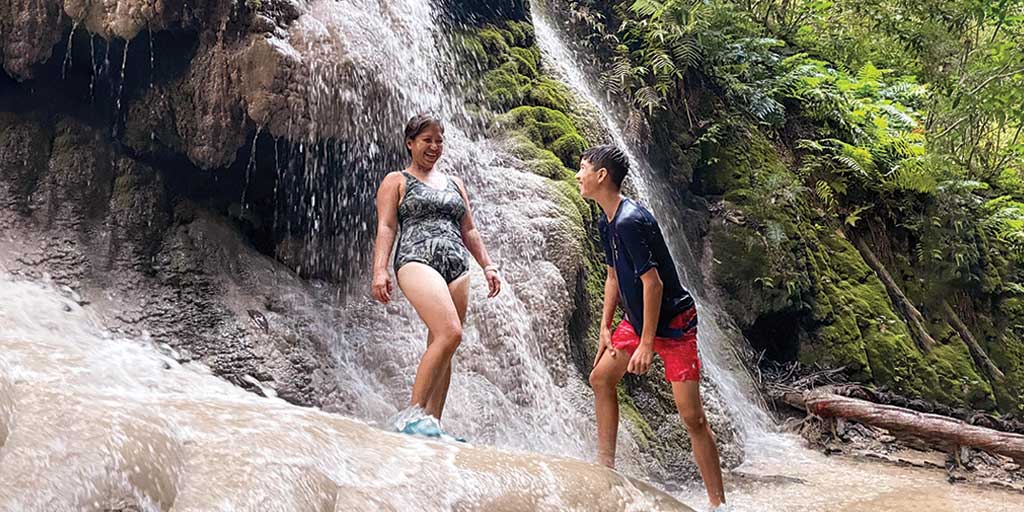
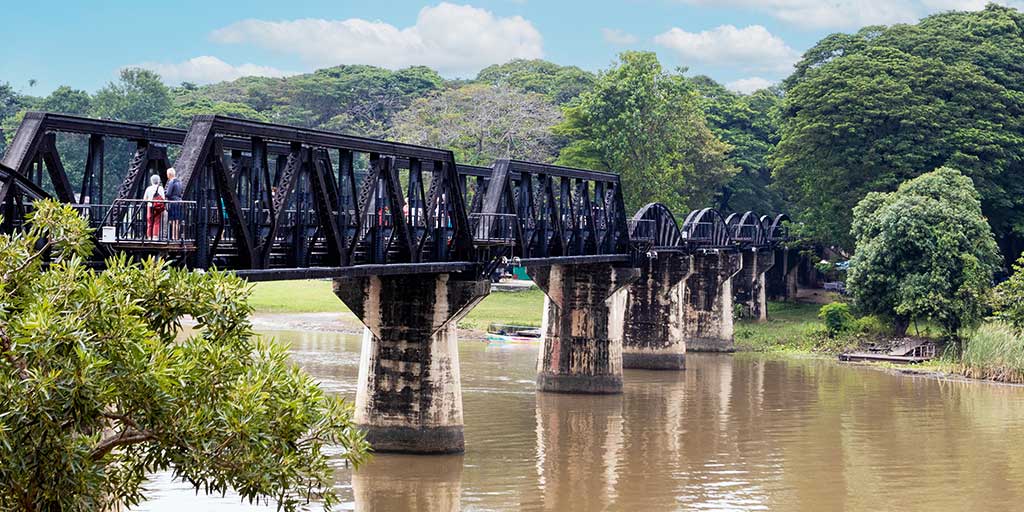
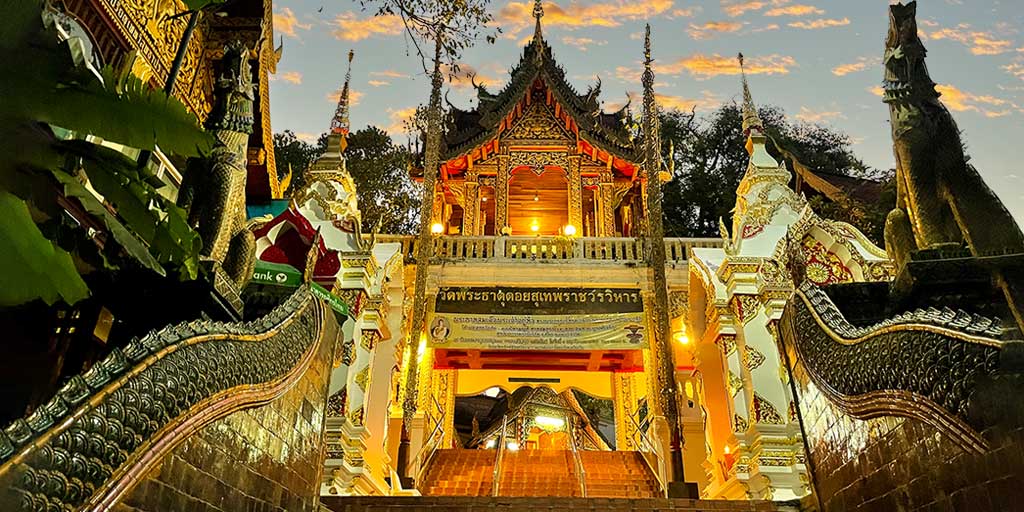
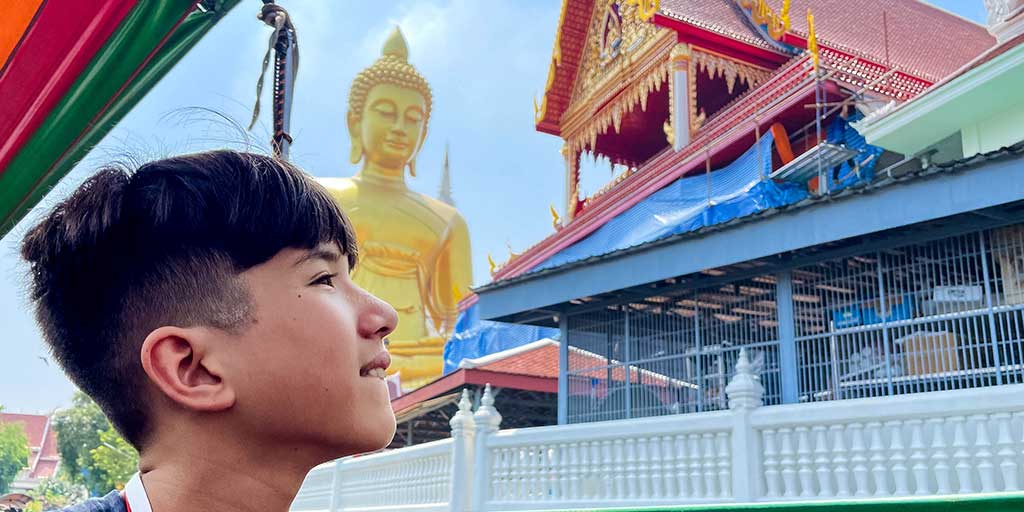
jyl
Sunday 9th of April 2023
Interesting article on the subject, we also got puzzled and also learn a lot there, especially after staying 3 days there!
Best, Jyl and Francesca